When fully ripe and properly processed, wild persimmons—a.k.a. American persimmons—are sweet and mild. Here’s how to find and use them.
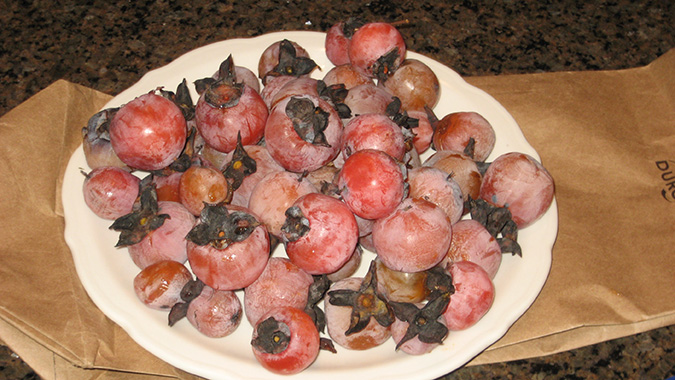
How to Find and Use Wild Persimmons
Every year, I look forward with anticipation to the wild persimmon season. Although the American persimmon (not the big, bright Asian persimmons) is a humble fruit, enjoyed by more animals than humans, it is as much a part of the seasons and my culture and heritage as gathering blackberries and “buckshot” blueberries in the summer, oysters in the winter, or poke “salat greens” in the spring.
You May Also Enjoy:
“Acorns: The Best Wild Food for Beginning Foragers”
“Wild Mushroom Foraging: Identifying and Eating Foraged Plants”
Wild persimmons and pawpaws are the two main indigenous fruits one will seldom, if ever, see in markets.
Wild persimmons are edible for only a brief time, usually near the first frost, and only when they appear to be overripe in comparison to say, a plum. They are ripe when they are soft—even mushy—and the skin splits easily.
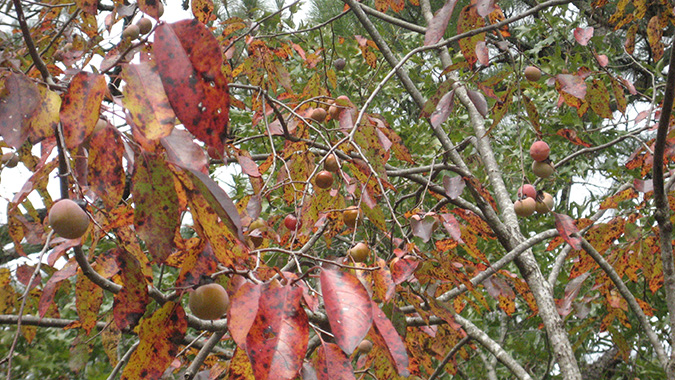
Wait to Eat Them Until They’re Fully Ripe!
Although folk lore says the frost sweetens them, they really just take longer than any other fruit to fully ripen. Prior to becoming fully ripe, persimmons are among the most bitter and astringent foods known to man!
Nearly every child who grows up in the country goes through that common right of passage, being tricked into eating an unripe persimmon. The mouth puckers uncontrollably, all sense of taste is lost, and the tongue feels “furry.”
You May Also Enjoy:
“Go Mushroom Foraging (Without Melting Your Organs)”
“15 Wild Foods That Will Keep You Alive In An Emergency”
“Dandelions: 31+ Uses for the King of Weeds”
“How to Not Die While Wildcrafting: 15 Rules for Foraging Safely”
Unfortunately, that lesson causes many to never try wild persimmons again.
I don’t have a clear memory, but I’d be willing to wager that the family member who played that trick on me was either my grandfather or my great grandmother—both were pranksters, but my great grandmother had a particular fondness for convincing the “young ‘uns” to do things like eat cayenne peppers while out in the fields, far from a water spigot. Granny was a spitfire!
Finding Wild Persimmons
The fall leaves of the persimmon feature shades of yellow and red. Persimmon trees are low-growing, rarely more than 10 feet high, and very visible in the understory. The fruit hangs like ornaments on a Christmas tree, in bright, festive orbs.
You May Also Enjoy:
“Sodium for Survival: 8 Ways to Find This Essential Nutrient in the Wilderness”
“Elderberry: Natural Remedy for Colds, the Flu, Inflammation … Even Cancer!”
As the air cools and the leaves turn, the persimmons turn from pale yellow to bright orange, then to ruby red, and finally to a soft, powdery rose/purple. The deer eat most of the lower fruit and groundfalls. Raccoons, opossums, and birds eat the fruit higher up.
Persimmon and hickory trees are the trees for scouting game where I live.
And, we may as well dispense with formality … no one says “raccoon” or “opossum” that actually spends time in the woods. We say “coon” and “possum,” and often jest that Mr. O’Possum must be the American possum’s Irish cousin!
An Aside on Eating Coons and Possums
Well, where I come from, folks aren’t too proud to eat coon and possum. In fact, even a generation ago, it was common practice to raise possums in a pit behind the house, feeding them on kitchen scraps, the way one would raise chickens.
Coons were often kept in cages and fed a good diet to “clean them out.” Both are opportunistic eaters that are famous for eating road kill and raiding trash cans. When that is their diet, the fat is said to smell strong and “gamey.”
Good diet is key to good game meat, and rural lore is that the very best diet for those two “critters” is persimmons and hickory nuts.
This is part of Southern, Scots-Irish tradition often spoken of with pride and the sentiment of surviving the hard times.
Common Country Culture
I well recall stopping at a service station where there used to be a town on a chilly fall morning. The mill that had been the heart of the town was being torn down, and there wasn’t much left except a gas station, a barbershop, one old church, and an antique store.
I sat down beside a small-framed, wiry man who had bushy hair and a long beard. He reminded me of my old friend, the late moonshiner Popcorn Sutton. He was visibly shaking.
I offered him a Parodi cigar, but he said he preferred his own brand of cheap cigarettes. So we poured some coffee, and sat and smoked while he told stories about the town that used to be.
You May Also Enjoy:
“Foraging for Wild Grapes (+My Old Family Recipe for Grape Hull Preserves!)”
Slowly, he opened up as we found commonality in shared country culture.
He had been born just across the street. His father was an abusive alcoholic and his mother just left one day, leaving him as the oldest child to provide for several younger siblings. His father only came around occasionally to take any money they tried to save.
He fed his family from trapping and fishing, working odd jobs, and keeping a small patch of tobacco and a few chickens so they could sell the eggs.
He “grew up hard,” as they used to say. He joined the military and was decorated for his service. He came home and worked in the mill we were watching being knocked down. Now, he helped his childhood friend change tires and such.
Raised on Possum and Persimmons
He was a good man, quiet and humble, sad … the kind most people never get to know. He gave me a great recipe for snapping turtle stew, flavored with sassafras! He “liked to cook a bit” when his stomach would let him.
You May Also Enjoy:
“3 Ways to Garden Without Land”
As we chatted, a yuppie came in with a new sports car. He was older than me and younger than the old man—a baby boomer “with more money than sense,” as my friend would say. He heard us talking about hunting and fishing and eventually joined in the conversation.
Oh, he loved to hunt deer and ducks and fish for marlin and to travel the world, but he didn’t really “have a taste” for game. He was a trophy hunter and very proud of it and of his expensive guns and boats.
I commented something like, “Well, I just wish there was some public land around here or an old farm I could get permission to hunt. It is persimmon season and I’d love just to put a possum in the pot.”
The yuppie replied with indignant shock, “I would never eat a trash animal like that!”
Well, you never know what is going to happen in a clannish, Scots-Irish rural community—one where coon is eaten for Thanksgiving instead of turkey, and hunting with dogs is a source of cultural pride.
That little old man, who weighed maybe 90 pounds, rose up to his full 5’4″ inches or so and steeled his shaky voice: “I’ve ate many a possum in my life. Possum kept us from starving. I will fight any man who says possum ain’t good food!”
I noticed the old man that owned the service station convulsing in laughter as the yuppie muttered “yes, sir” and slunk out to the parking lot.
Cooking With Wild Persimmons
Well, that brings me to cooking with wild persimmons, and the crowning jewel of that endeavor is my mother’s persimmon bread. Here’s the recipe:
My Mother’s Persimmon Bread Recipe
1 cup sugar
1/2 stick butter
2 eggs
1/2 teaspoon vanilla extract
1-1/2 cups plain flour
1/2 teaspoon salt
1/2 teaspoon baking soda
1-1/2 teaspoons baking powder
1 cup strained persimmon pulp
(optional: nuts, raisins, cinnamon, etc.)
Mix all ingredients together until blended. Pour into greased loaf pans. Bake approximately 1 hour at 350°F.
The key in cooking with wild persimmons is not only to remove all seeds, but also the skin and little black specks. To do this, you push the fruit from some kind of strainer and use the pulp. It is impossible to remove all trace of bitterness from wild persimmons, but processed this way, it is no more bitter than chocolate, but sweet and mild. It needs the spices and flavors of the season to bring out its full flavor.
Simple Roasts With Gourmet Flavors
Having surveyed my old cookbooks—regional Southern cookbooks published before 1910 and those from the classic era of the great hunting lodges and sportsman clubs (say, pre-1960)—I found many recipes that combined persimmons with the game that fed on them.
Classic Appalachian Roast Possum
The classic Appalachian roast possum with sweet potatoes uses persimmons halved and seeded—but they can be prepared in the same way as one would for persimmon bread, using the pulp as a glaze for the meat. The critter is generally soaked overnight in a brine of water, apple cider vinegar, and salt to “take out the gaminess,” but I know many people skip this step.
Then, roasted in a pan with sweet potatoes, onions, turnips, or rutabagas, carrots, etc., the fat and juices from the root vegetables brown and make a pan gravy that is nice, savory, and a little sweet. If vinegar was used, it is also a bit sour.
That is a classic flavor combination found throughout Europe and Asia, usually reserved for holidays and special celebrations of the winter season. If you don’t use vinegar, I would recommend serving the meat and roasted vegetables with homemade sauerkraut, to balance the sweetness.
I’m reminded of an alpine dish that combines fatty sausages with sweet spices, and sauerkraut served soaked in champagne—now that would fancy up your possum with sweet potatoes and persimmons!
Persimmons With Pork, Duck, Turkey, and More
Well, I don’t reckon most of my readers will use their precious persimmons on a possum or coon. Never fear, the classic cookbooks give us many options, from Louisiana glazed ham to roast goose. One could easily match and even enhance the above flavor profiles using pork roast; duck; or a nice, plump turkey—anything with some good, rich fat.
Instead of a vinegar brine, we could use an acidic, fruity wine like pinot noir in the roasting pan, a dark beer, and a few slices of citrus or, perhaps best of all, a citrus/green apple–flavored hard cider.
You May Also Enjoy:
“Organic Wine That Actually Tastes GOOD!”
Celery or fennel, especially with the tops, would make the flavor more aromatic. Mushrooms could add depth. We could use herbs. Sage, thyme, or rosemary would be very nice. A few cloves would work nicely with the onions.
A few crushed pecans, walnuts or hickories added at the end to brown in the fat would give it a wonderful nuttiness … and maybe a dash of brandy or whiskey to really round out the gravy and bring it to the nose.
Such simple roasts are gourmet territory in terms of flavor, but down-home and comforting. They color the memories of crisp late-year evenings with a golden hue.
Other Creative Uses for Wild Persimmons
Other recipes I discovered include persimmon and pecan ice cream, persimmon beer (made with stale persimmon bread), dried persimmons, pickled persimmons, and so much more.
Our ancestors, whether native or immigrant, especially in the early days of settlement, would never have taken the lowly persimmon for granted. Nor should we.
It is free food that is something you simply cannot buy. Such flavors are priceless.
Moreover, the other day, as I picked persimmons in the cold, pouring rain, I realized that in doing that, I was happier than I had been in a long time. Of course, I did pick some unripe persimmons—you can see them above, to the right of the ripe ones on the plate.
To ripen unripe persimmons, enclose them in a paper bag with an apple or banana. They will ripen within a couple of days—no frost necessary!
What Do You Think?
Have you ever eaten wild persimmons? What’s your favorite way to use them? Let us know in the comments!
________
The Grow Network is a participant in the Amazon Services LLC Associates Program, an affiliate program designed to provide a means for our team to earn fees for recommending our favorite products! We may earn a small commission at no additional cost to you should you purchase an item after clicking one of our links. Thanks for supporting TGN!

The Grow Network is a global network of people who produce their own food and medicine. We’re the coolest bunch of backyard researchers on Earth! We’re constantly sharing, discovering, and working together to test new paths for sustainable living—while reconnecting with the “old ways” that are slipping away in our modern world. We value soil, water, sunlight, simplicity, sustainability, usefulness, and freedom. We strive to produce, prepare, and preserve our own food and medicine, and we hope you do, too!
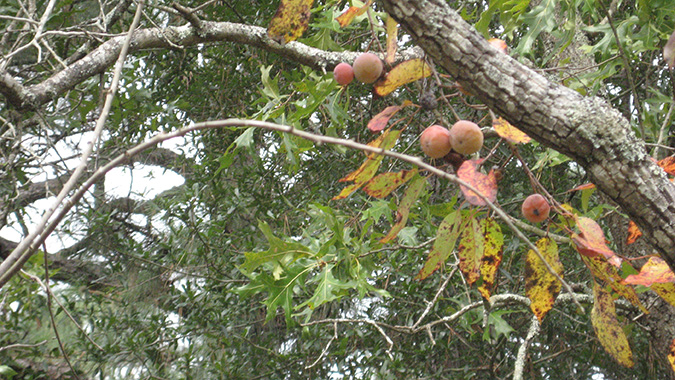
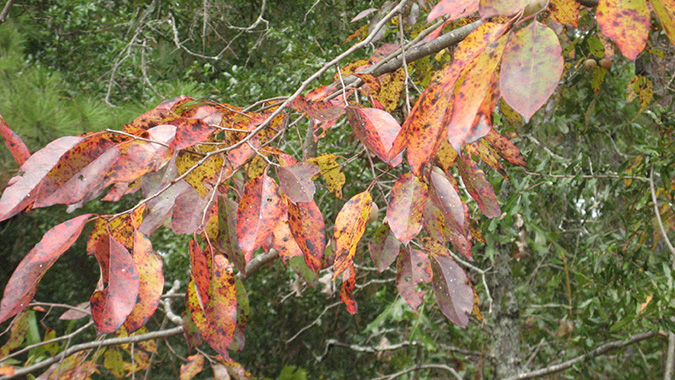

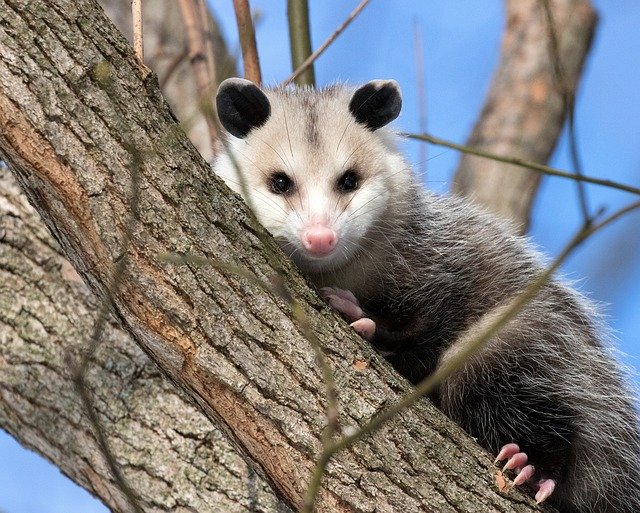
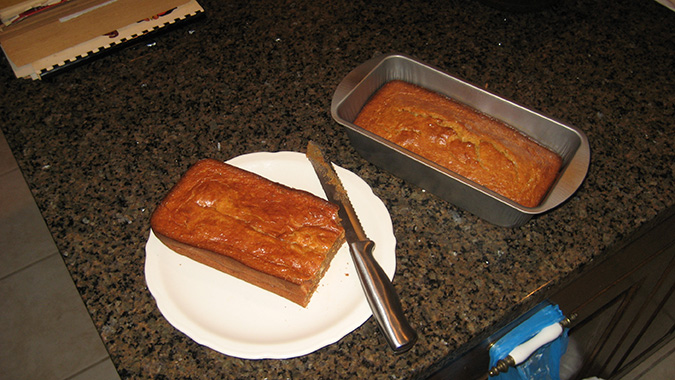
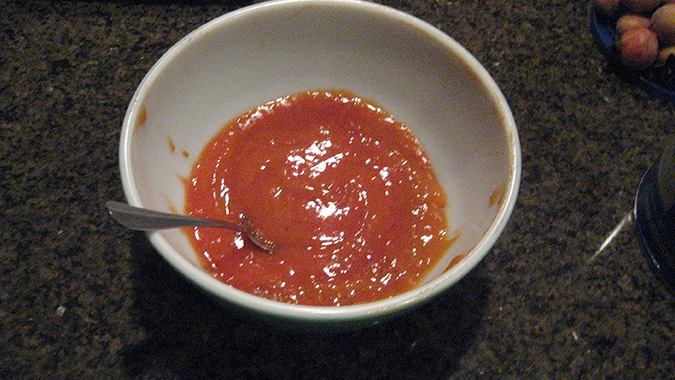
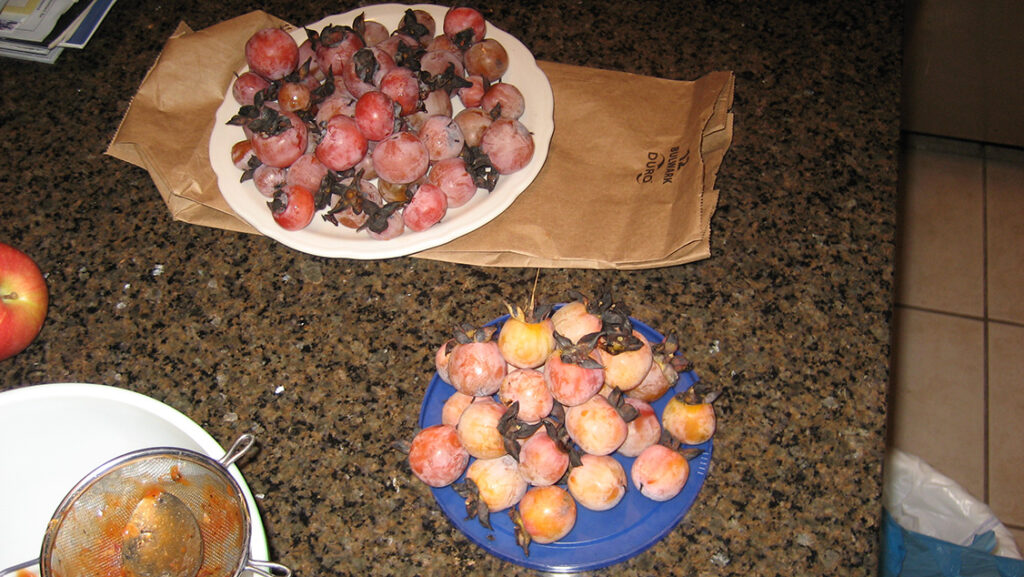







COMMENTS(6)
Would you happen to have a relatively easy way to get the pulp? I’ve tried “smushing” them in a colander and don’t have the patience to try to get those seeds out by hand. I have a large persimmon tree out in the front yard but I tend to let the deer have them since I haven’t figured out a way to process them.
Yes. I used a tea strainer and a spoon for those. But, a colander works better and much better than that is a fruit cone like the one pictured in this discussion: https://community.thegrownetwork.com/discussion/845360/an-ode-to-wild-persimmons-my-mother-s-recipe-for-persimmon-bread-and-roast-possum#latest
I use a flat colander and a ceramic coffee cup with rounded edges. Put it over a large bowl and smush away. Do this till you have most of the seeds cleaned. Then scrape the pulp off the bottom in to the large bowl. Throw away the seeds, or use them to plant more trees.Put the pulp into pint plastic containers and freeze. Freezing helps make the pulp better for cooking.
I’ve never eaten American persimmons- don’t see them growing around here. But Texas persimmons make wonderfully sweet jelly that needs no pectin. They grow wild all over my property. (They surprise eaters of American persimmons as they are black and not orange) supposedly the seeds make a great coffee substitute, but they are hard enough to kill grinders and I don’t drink coffee, so have never tried.
That is really cool – I’ll have to try them next time I’m down that way!
I picked up a Weston tomato press this summer that I use to seed raspberries, blueberries, strawberries, tomatoes, etc and make some wonderful apple sauce in record time, I bet it would be perfect for this too and I can’t wait to try it. We have a few trees on our property, I wonder if the possums have left us any? Terrific article!